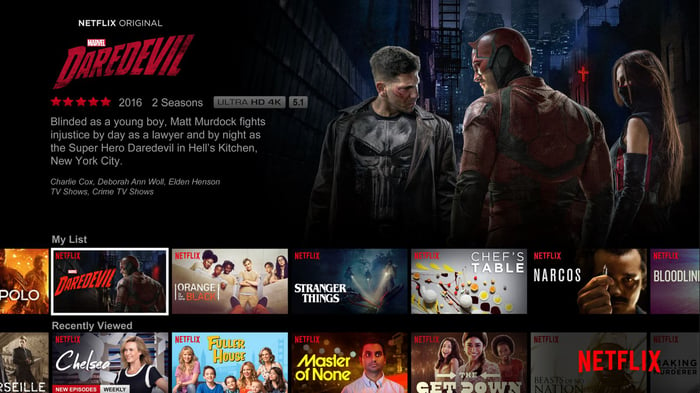Netflix (NFLX 1.87%) stock has surged higher in the past two years, driven by the streaming video pioneer's explosive global growth. Indeed, the company ended last quarter with 125 million streaming subscribers on a global basis, up from 81.5 million two years earlier.
Its shares have nearly quadrupled since the middle of 2016, boosting Netflix's market cap from around $40 billion to more than $150 billion. Last week, it became the most valuable media company in the world.
Netflix market capitalization. Data by YCharts.
However, investors may have become too excited about Netflix stock. While the company clearly has lots of room left for growth, it will struggle to make enough money over time to justify its current $155 billion market cap.
Limited room for revenue per customer growth
Among the four high-flying "FANG" stocks, Netflix and Amazon.com (AMZN 2.39%) stand out for having particularly high valuations. Netflix stock trades for roughly 124 times the average analyst earnings-per-share estimate for 2018. Amazon isn't much different. It trades for about 129 times the average 2018 EPS estimate.
Clearly, investors expect massive revenue growth and margin expansion for both companies. However, Amazon has one huge advantage over Netflix in this respect: It has far more room to increase revenue per customer.
Amazon is steadily expanding into new product categories and lines of business while improving its existing offerings. It also invests a huge amount of money in expanding its fulfillment network, in order to offer better (and faster) service. Amazon's 2017 purchase of Whole Foods gave it instant credibility in the massive grocery market. Amazon also gained a substantial footprint of brick-and-mortar locations, which it is using to offer enhanced service to customers.
In fact, virtually everything Amazon does is designed to convince customers to sign up for Prime, use more Amazon services, and buy more products from Amazon. As a result, Amazon may still be far from its ceiling in terms of revenue per customer.
Whereas Amazon's brand is built around the idea of offering everything under one roof, Netflix has adopted an extremely narrow mission. As management puts it, "Netflix is a focused passion brand" that sticks to commercial-free streaming of movies and TV series for a low monthly fee. In keeping with its brand positioning, the company has shied away from bidding for live sports, let alone creating a "skinny bundle" of traditional cable channels.

Netflix plans to maintain a very focused mission. Image source: Netflix.
Based on Netflix's rapid subscriber growth, it's clear that this strategy has worked. But it makes it a lot harder to grow revenue per customer. Netflix rolled out its first streaming-only plan in the U.S. in late 2010, priced at $7.99 per month. Late last year -- i.e., seven years later -- the price of its standard plan reached $10.99 per month. Furthermore, there is still a basic option priced at $7.99 per month for more cost-sensitive consumers.
Netflix may be able to raise its subscription price by $1 per month every year or two without much customer pushback. However, it would take more than a decade to double revenue per customer at that rate. Thus, while Amazon can keep growing quickly just by increasing revenue per customer, Netflix must rely primarily on subscriber growth to increase its revenue.
It's already getting harder to bring in new subscribers
At first glance, Netflix's rapid subscriber growth would seem to indicate that its limited ability to boost revenue per customer is not a big problem. However, Netflix has relied on huge increases in marketing spending to drive its recent subscriber growth.
Last year, it increased its marketing spending by 29% year over year, to $1.3 billion. However, in both 2016 and 2017, subscriber count rose by 25%. In 2018, the company plans to spend a whopping $2 billion on marketing.
This spending may be a good investment, but if Netflix needs to spend ever-increasing sums on marketing to build buzz for its original content, that will cut into its potential for margin expansion. Thanks to the tailwind of a major price increase, its revenue surged 41% year over year last quarter. Nevertheless, marketing spending rose even faster, reaching 12.9% of total revenue, compared to 10.3% of revenue a year earlier.
Great isn't good enough
As I noted last month, Netflix probably needs at least $60 billion of annual revenue to generate $10 billion of free cash flow annually. It's certainly plausible that Netflix will reach this size at some point in the 2020s. One way of getting there would be a roughly $5 per month increase in average revenue per user (to $16.67 per month or $200 per year) and a global subscriber count of 300 million.
However, given that Netflix estimates its domestic addressable market at 60 million to 90 million subscribers, it's not clear that it would have much growth potential beyond that level. For example, with a domestic subscriber base of 80 million, Netflix would need to get 73% of its subscribers from abroad to reach a worldwide total of 300 million.
A business with $10 billion of free cash flow and a single-digit growth rate might be worth $200 billion. But it could take close to a decade for Netflix to reach this level of size and profitability. It doesn't make sense to pay more than $150 billion today for a business that might be worth $200 billion in the mid-late 2020s.
Thus, great results from Netflix won't be enough for the company to grow into its valuation. It would need to grow to a truly extraordinary size to pay off for long-term investors who buy now.






